washer fluid TOYOTA FJ CRUISER 2013 1.G Owners Manual
[x] Cancel search | Manufacturer: TOYOTA, Model Year: 2013, Model line: FJ CRUISER, Model: TOYOTA FJ CRUISER 2013 1.GPages: 568, PDF Size: 9.49 MB
Page 152 of 568

152 2-3. Operating the lights and wipers
■The windshield wiper and washer can be operated when
The engine switch must be in the ON position.
■ If no windshield washer fluid sprays
Check that the washer nozzles are not blocked and if there is washer fluid in
the windshield washer fluid reservoir.
NOTICE
■When the windshield is dry
Do not use the wipers, as they may damage the windshield.
■ When there is no washer fluid spray from the nozzle
Damage to the washer fluid pump may be caused if the lever is pulled
toward you and held continually.
■ When a nozzle becomes blocked
In this case, contact your Toyota dealer.
Do not try to clear it with a pin or other object. The nozzle will be damaged.
Washer/wiper dual opera-
tion
Wipers will automatically oper-
ate a couple of times after the
washer squirts.
Page 153 of 568

153
2-3. Operating the lights and wipers
2
When driving
Rear window wiper and washer
: If equipped
■The rear window wiper and washer can be operated when
●The engine switch must be in the ON position.
● The glass hatch is closed.
NOTICE
■When the rear window is dry
Do not use the wipers, as they may damage the rear window.
■ When there is no washer fluid spray from the nozzle
Damage to the washer fluid pump may be caused if the knob is continuously
twisted upward or downward as far as it will go.
Intermittent window wiper
operation.
The wiper operates 3 times at
normal speed and then moves
to intermittent mode.
Normal window wiper oper-
ation
Washer/wiper dual opera-
tion
Washer/wiper dual opera-
tion
The rear window wiper oper-
ates while the washer squirts.
Page 211 of 568
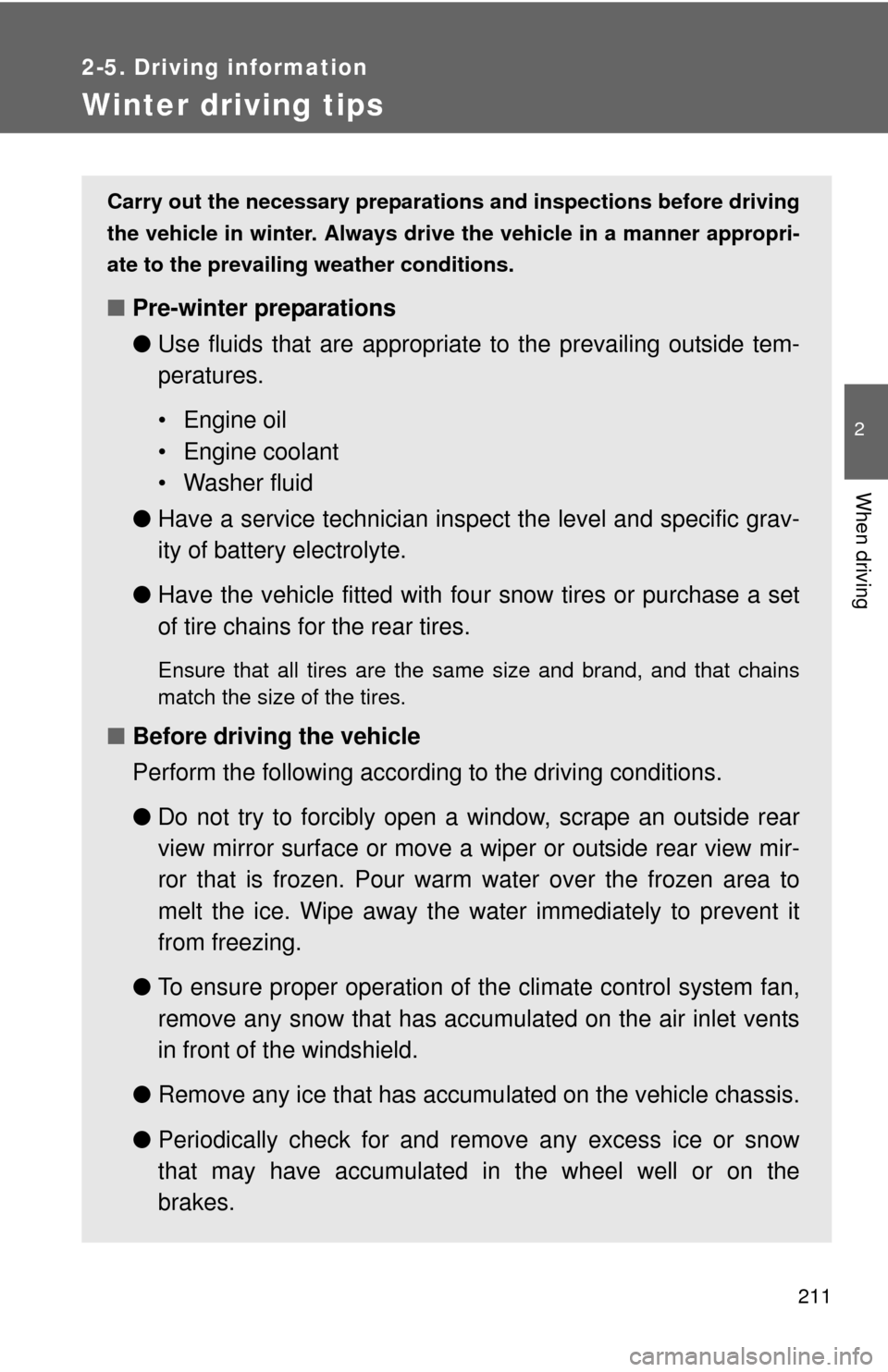
211
2-5. Driving information
2
When driving
Winter driving tips
Carry out the necessary preparations and inspections before driving
the vehicle in winter. Always drive the vehicle in a manner appropri-
ate to the prevailing weather conditions.
■ Pre-winter preparations
●Use fluids that are appropriate to the prevailing outside tem-
peratures.
• Engine oil
• Engine coolant
• Washer fluid
● Have a service technician inspect the level and specific grav-
ity of battery electrolyte.
● Have the vehicle fitted with four snow tires or purchase a set
of tire chains for the rear tires.
Ensure that all tires are the same size and brand, and that chains
match the size of the tires.
■Before driving the vehicle
Perform the following according to the driving conditions.
●Do not try to forcibly open a window, scrape an outside rear
view mirror surface or move a wiper or outside rear view mir-
ror that is frozen. Pour warm water over the frozen area to
melt the ice. Wipe away the water immediately to prevent it
from freezing.
● To ensure proper operation of th e climate control system fan,
remove any snow that has accumulated on the air inlet vents
in front of the windshield.
● Remove any ice that has accumu lated on the vehicle chassis.
● Periodically check for and remove any excess ice or snow
that may have accumulated in the wheel well or on the
brakes.
Page 400 of 568

400
4-2. Maintenance
General maintenance
Engine compartment
ItemsCheck points
Battery Maintenance-free. ( P. 418)
Brake fluid At the correct level? ( P. 415)
Engine coolant At the correct level? ( P. 413)
Engine oil At the correct level? ( P. 410)
Exhaust system No fumes or strange sounds?
Power steering fluid At the correct level? ( P. 417)
Radiator/condenser/hoses Not blocked with foreign matter?
(P. 415)
Washer fluid At the correct level? (P. 421)
Listed below are the general maintenance items that should be per-
formed at the intervals specified in the “Scheduled Maintenance
Guide” or “Owner’s Manual Supp lement”. It is recommended that
any problem you notice should be brought to the attention of your
Toyota dealer or qualified service shop for advice.
Page 405 of 568
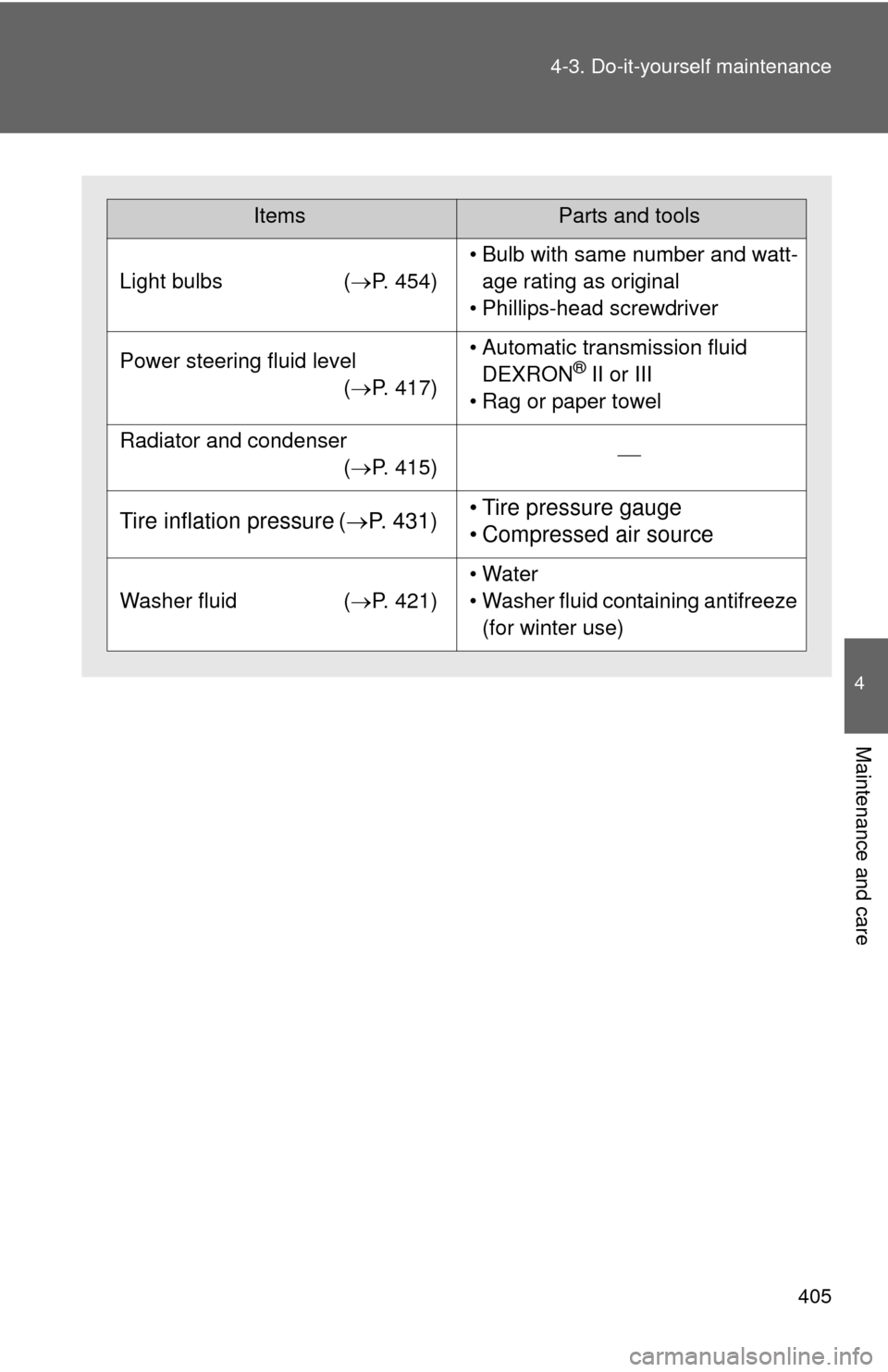
405
4-3. Do-it-yourself maintenance
4
Maintenance and care
ItemsParts and tools
Light bulbs
(P. 454)
• Bulb with same number and watt-
age rating as original
• Phillips-head screwdriver
Power steering fluid level (P. 417)• Automatic transmission fluid
DEXRON® II or III
• Rag or paper towel
Radiator and condenser (P. 415)
Tire inflation pressure ( P. 431)• Tire pressure gauge
• Compressed air source
Washer fluid (P. 421)
• Water
• Washer fluid containing antifreeze
(for winter use)
Page 409 of 568
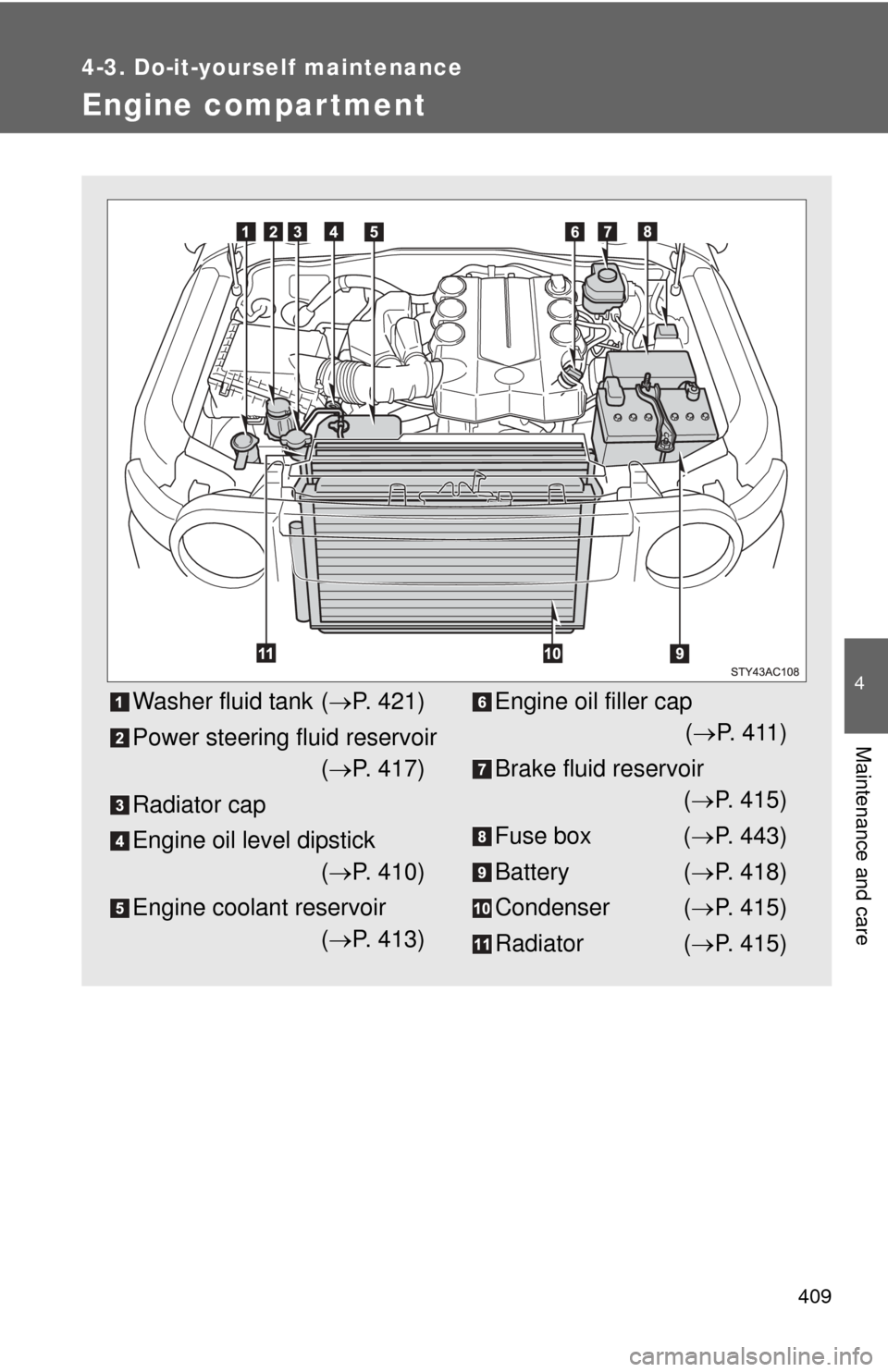
409
4-3. Do-it-yourself maintenance
4
Maintenance and care
Engine compar tment
Washer fluid tank (P. 421)
Power steering fluid reservoir ( P. 417)
Radiator cap
Engine oil level dipstick ( P. 410)
Engine coolant reservoir ( P. 413)Engine oil filler cap
( P. 4 11 )
Brake fluid reservoir ( P. 415)
Fuse box ( P. 443)
Battery ( P. 418)
Condenser ( P. 415)
Radiator ( P. 415)
Page 421 of 568
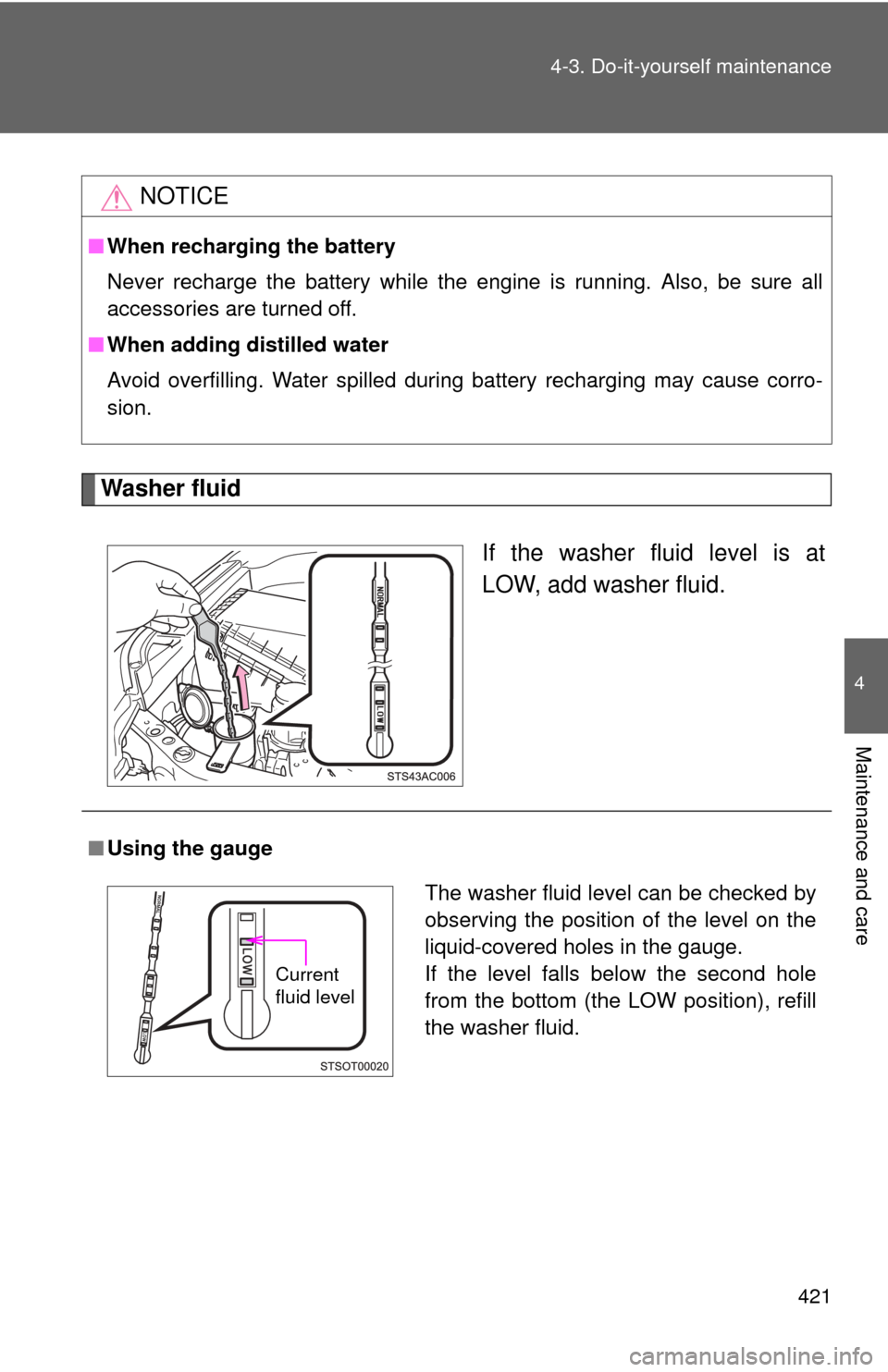
421
4-3. Do-it-yourself maintenance
4
Maintenance and care
Washer fluid
If the washer fluid level is at
LOW, add washer fluid.
NOTICE
■When recharging the battery
Never recharge the battery while the engine is running. Also, be sure all
accessories are turned off.
■ When adding distilled water
Avoid overfilling. Water spilled during battery recharging may cause corro-
sion.
■Using the gauge
The washer fluid level can be checked by
observing the position of the level on the
liquid-covered holes in the gauge.
If the level falls below the second hole
from the bottom (the LOW position), refill
the washer fluid.
Current
fluid level
Page 422 of 568

422 4-3. Do-it-yourself maintenance
CAUTION
■When refilling the washer fluid
Do not refill the washer fluid when the engine is hot or running, as the
washer fluid contains alcohol and may catch fire if spilled on the engine etc.
NOTICE
■Do not use any fluid other than washer fluid
Do not use soapy water or engine antifreeze instead of washer fluid.
Doing so may cause streaking on the vehicle’s painted surfaces.
■ Diluting washer fluid
Dilute washer fluid with water as necessary.
Refer to the freezing temperatures listed on the label of the washer fluid bot-
tle.
Page 476 of 568
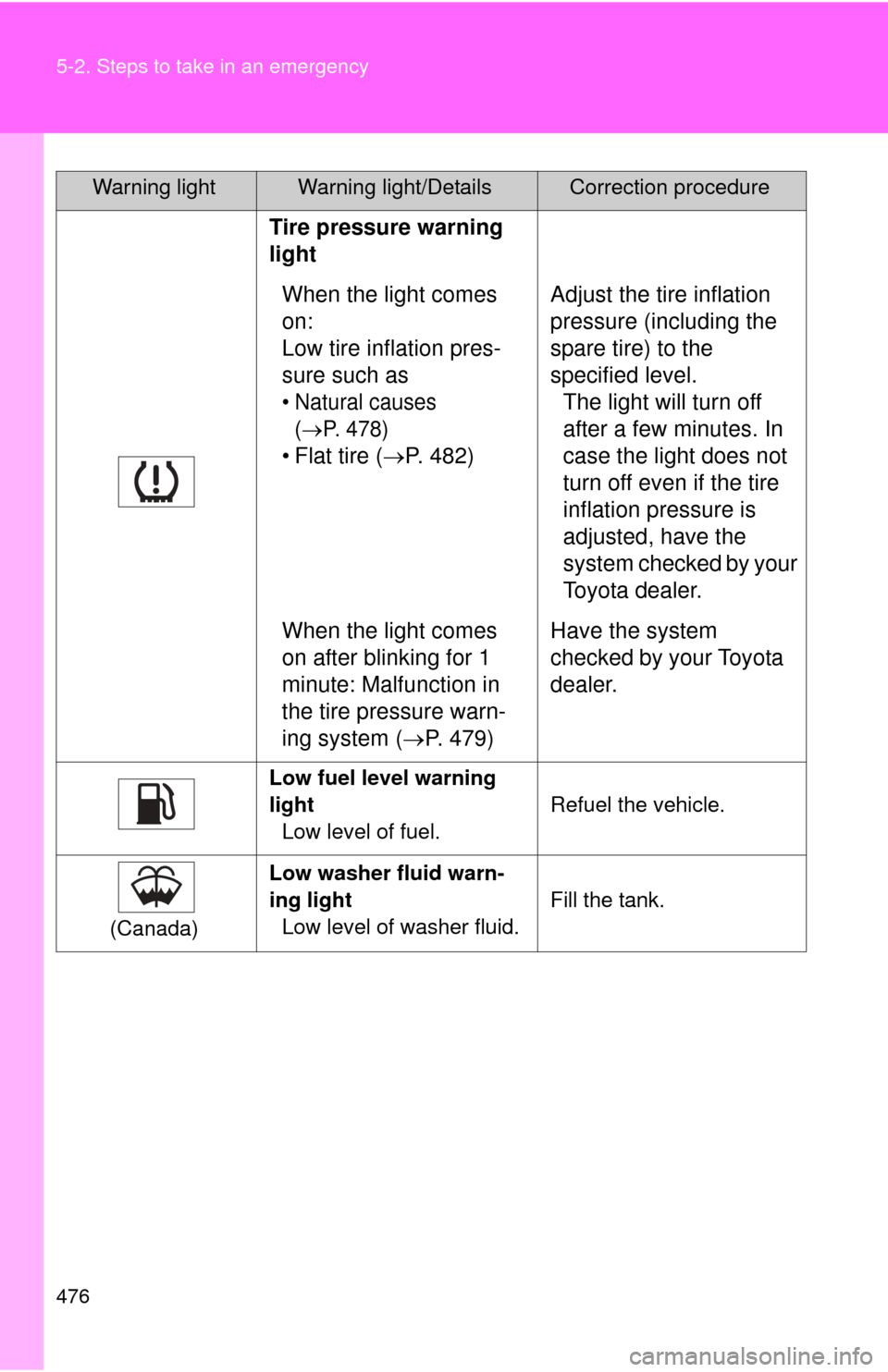
476 5-2. Steps to take in an emergency
Tire pressure warning
lightWhen the light comes
on:
Low tire inflation pres-
sure such as
• Natural causes (
P. 478)
• Flat tire ( P. 482) Adjust the tire inflation
pressure (including the
spare tire) to the
specified level.
The light will turn off
after a few minutes. In
case the light does not
turn off even if the tire
inflation pressure is
adjusted, have the
system checked by your
Toyota dealer.
When the light comes
on after blinking for 1
minute: Malfunction in
the tire pressure warn-
ing system ( P. 479) Have the system
checked by your Toyota
dealer.
Low fuel level warning
light
Low level of fuel. Refuel the vehicle.
(Canada) Low washer fluid warn-
ing light
Low level of washer fluid. Fill the tank.
Warning lightWarning light/DetailsCorrection procedure
Page 558 of 568
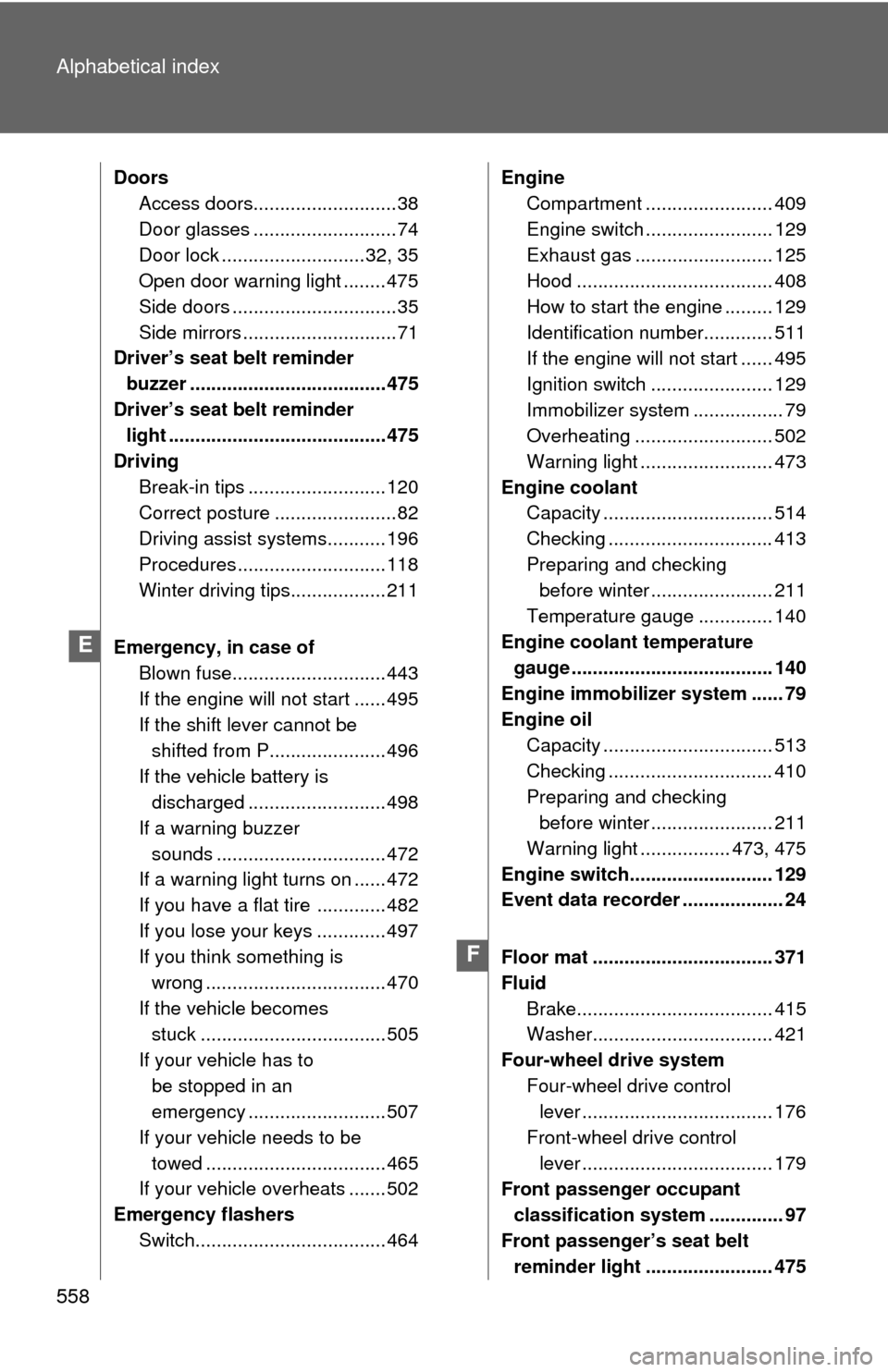
558 Alphabetical index
DoorsAccess doors...........................38
Door glasses ...........................74
Door lock ...........................32, 35
Open door warning light ........ 475
Side doors ...............................35
Side mirrors .............................71
Driver’s seat belt reminder
buzzer ..................................... 475
Driver’s seat belt reminder light ......................................... 475
Driving Break-in tips .......................... 120
Correct posture .......................82
Driving assist systems........... 196
Procedures ............................ 118
Winter driving tips.................. 211
Emergency, in case of Blown fuse............................. 443
If the engine will not start ...... 495
If the shift lever cannot be shifted from P...................... 496
If the vehicle battery is discharged .......................... 498
If a warning buzzer sounds ................................ 472
If a warning light turns on ...... 472
If you have a flat tire ............. 482
If you lose your keys ............. 497
If you think something is
wrong .................................. 470
If the vehicle becomes stuck ................................... 505
If your vehicle has to be stopped in an
emergency .......................... 507
If your vehicle needs to be towed .................................. 465
If your vehicle overheats ....... 502
Emergency flashers Switch.................................... 464 Engine
Compartment ........................ 409
Engine switch ........................ 129
Exhaust gas .......................... 125
Hood ..................................... 408
How to start the engine ......... 129
Identification number............. 511
If the engine will not start ...... 495
Ignition switch ....................... 129
Immobilizer system ................. 79
Overheating .......................... 502
Warning light ......................... 473
Engine coolant Capacity ................................ 514
Checking ............................... 413
Preparing and checking before winter ....................... 211
Temperature gauge .............. 140
Engine coolan t temperature
gauge ...................................... 140
Engine immobilizer system ...... 79
Engine oil Capacity ................................ 513
Checking ............................... 410
Preparing and checking before winter ....................... 211
Warning light ................. 473, 475
Engine switch........................... 129
Event data recorder ................... 24
Floor mat .................................. 371
Fluid Brake..................................... 415
Washer.................................. 421
Four-wheel drive system Four-wheel drive control lever .................................... 176
Front-wheel drive control lever .................................... 179
Front passenger occupant
classification system .............. 97
Front passenger’s seat belt reminder light ........................ 475
E
F